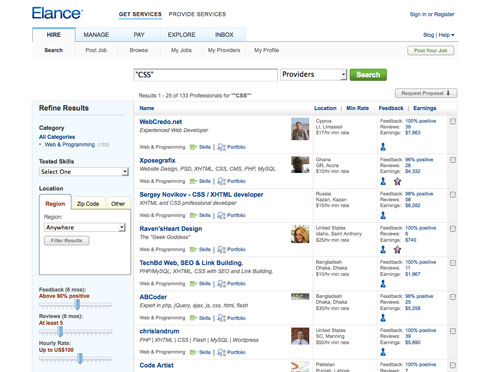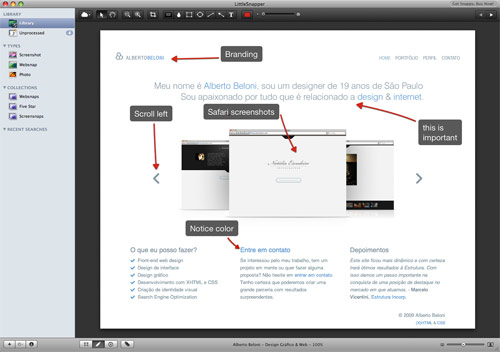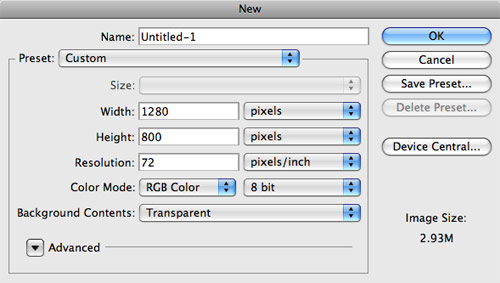Designers: How to Search For, Hire, and Work With a Web-Developer

The market for freelance web design is huge. Being able to design a beautiful site in Photoshop is one thing. Programming a website is a whole other story.
So when clients come knocking at your door asking for web design services, what do you, the non-programmer but rockstar designer, tell them? "Sorry, I only design, I don't code." No! You take the job, and team up with an equally rockstar-esque programmer to develop the site that you design.
Easy, right? Well... not exactly. In case you haven't noticed, there are many (too many) "hack" programmers out there. They talk up their capabilities, techie background, and all powerful programming skills, but just can't deliver the quality results your project and your client deserve. Finding the gem in the bunch can be a tough task.
Sub-contractors can often make or break a client project. It takes a high level of trust, communication, and organizational skills to make your working relationship a success. For designers, programming can quickly becoming a confusing mess of code and technical jargon. I aim to clear things for you in this article.
As both a designer and a programmer, I have experience working in both ends of web development. Today, I'd like to help designers bridge the gap between the design side and programming side so that you can tap into the massive pool of web design clients. Here's what we'll cover:

 LittleSnapper
A fantastic tool for taking and marking up screenshots
LittleSnapper
A fantastic tool for taking and marking up screenshots
 Setting up a new document for the web in Photoshop
It also helps to provide un-flattened documents. This way programmers can disable / enable layers when cutting all of the necessary images to construct the website. Also, if you need the text taken straight from the PSD, it's best to easily cut and paste text rather than retype it.
Setting up a new document for the web in Photoshop
It also helps to provide un-flattened documents. This way programmers can disable / enable layers when cutting all of the necessary images to construct the website. Also, if you need the text taken straight from the PSD, it's best to easily cut and paste text rather than retype it.
- Searching for programmers: Where to look?
- Hiring the right programmer: Things to look out for.
- Working with a programmer: Tips for success.
Searching for programmers: Where to look?
There are tons of places to search for a programmer, many of which should already be familiar to you. Here's my list of go-to resources with the preferred outlets listed first:1) Referrals from your trusted network.
Before you hit the job boards, it's best to reach out to your co-workers, friends, or anyone you trust within the web industry. Going with a trusted recommendation is always your best starting point - especially if the the recommendation comes from first-hand working experience with the programmer. Your trusted network can even extend into your social media ring on Twitter, LinkedIn or Facebook. Reach out to those you have conversed with and gained trust in.2) Recognized industry experts.
If your budget allows for it, reach out to the most visible and trusted industry experts. The big "names". I'm talking about those who speak at conferences, author well-known books, or have popular blogs. Of course, these are not the only super-talented programmers you can hire (there are many lesser-known but equally rockstar web devs out there). But the "names" have earned their credibility with proven success and recognition.3) Job boards
When you've exhausted all other channels, it's time to hit the online job boards. There are lots to choose from. Here are some of best places to look:- FreelanceSwitch Job Board I like this one because it requires applicants to pay a low monthly fee. This helps to weed out the "hacks" from the reliable web workers.
- Elance A popular job site for freelancers. You can read reviews and ratings for each worker, with a visible work history.
- Odesk Similar features to Elance, plus a built in time tracking component. Odesk allows you view hours worked plus see screenshots of your worker's activity. This one is good for smaller, hourly jobs.
- Authentic Jobs Postings for both full-time and freelance positions. Great for larger jobs with higher budgets.
- Sortfolio Here you can browse portfolios of designers, developers, and agencies.
- Smashing Jobs Of course, you can post your job listing here on Smashing Magazine for massive exposure.

Hiring a programmer: Things to look out for
Now that you've found a list of applicants, here's what you should look out for when sifting through their responses:1) Referrals, References, and Portfolio (in that order)
This is true when hiring anyone, really. Hiring a programmer based on a personal recommendation from someone you trust is always your best bet. If you don't have a personal referral, ask your potential programmer for references (with current contact info) from past clients, and contact them. Portfolios are important too. Click through to the sites they've developed and review the functionality. Question them on what exactly their role was in building these sites. Sometimes programmers might have coded the front-end CSS but left the database interaction work to someone else, or vice versa. It's important to know which core skill(s) are needed for your project and seek out this type of experience from a programmer or you can hire a frontend development team and be sure they will meet your requirements.2) Communication skills
This is among the most important qualities to look out for. A successful programmer must have the ability to communicate in clear terms all of the technical issues associated with your project. That means breaking down all of the intricacies, walking you through the processes, and detailing the problems and solutions associated with each process. They must also be good listeners and follow your instructions to a tee. Look for strong phone and email etiquette. In the end, the communication between you and your programmer will be what makes or breaks your project. A breakdown in communication can throw your project off track (and off budget). A strong working relationship will result in a happy client and future work for everyone involved.3) Specific expertise
Not all programmers do the same thing. You want to find a programmer who specializes in the type of programming your project requires. If you're designing an E-Commerce website, you should hire a programmer who has E-Commerce experience, not simply website experience in general. The key is to find a specialist. Beware of programmers who say they know a technology, but haven't really worked with it. You're better off going with someone who has a proven track record in a specific skill than hiring a "jack of all trades". A programmer who keeps a public blog is always a big plus in my book. That's a great way to read up on what they specialize in. It also shows they are passionate about their work and expertise.4) Availability
You want to make sure your programmer is available, not only to do the work but for regular chats and progress updates. Nothing is worse than a programmer who disappears for days or weeks at a time. Most web workers use IM or Skype. It's good to know that your programmer is signed in and available for email / IM on a regular basis. Question them on what else they have on their plate during the time frame of your project. Does your project require full-time availability (not shared among other projects) or is it small enough manage alongside other projects? These availability issues are important to clarify before starting work because you'll have additional assurance that deadlines will be met.5) Price
Obviously, staying within your budget for the project is important. However, focusing solely on the programmer's price quote will not result in the best hire. You should consider all of the above criteria along with your project budget to determine the best match. It's easy to choose the programmer with the lowest rate. But are they the right person for your specific task? With such a wide spectrum of price comparison in the programming field, there is no way to direclty relate price to results. Some programmers under charge and over deliver while others overprice themselves and turn out to be hacks. Once again, you must take all things into consideration when choosing the right programmer for your project. On the subject of price, most freelancers fall into two groups: Bill by the hour, or charge a flat fee. If they wish to bill you hourly, be sure to get an estimate of hours before beginning work. A good idea would be to set milestones for updates. For example, a progress update and review when 10 hours have passed, and again at 30 hours. A flat fee may be preferable because you know exactly what the cost will be. In this case, be sure to clearly map out all of the deliverables to be covered under the agreement. That way there are no discrepancies when it comes time for settlement.Working with a programmer: Tips for success
So you've hired a programmer and your project is underway. Here are some things to keep in mind to ensure your project goes smoothly:1) Articulate every detail
Don't assume the programmer knows what your goals are just by looking at the PSD. Take the time to discuss every functional detail, exactly how you envision it. What happens when the user clicks this button? What steps will the customer see as they proceed to checkout? What should happen when you roll the mouse over links? These are the types of questions that should be cleared up at the beginning of the project. It also helps to document the design notes, such as page and paragraph margins, line height, font choices, etc. A good programmer should match the details perfectly to the provided PSD, but don't assume. It's always better to be thorough in articulating the details. LittleSnapper
A fantastic tool for taking and marking up screenshots
LittleSnapper
A fantastic tool for taking and marking up screenshots
2) Provide web-ready designs
Some designers don't fully understand the structural constraints when designing for the web. The unit of measure on the web is pixels, and resolution is always 72 pixels per inch. If you provide a document at 300 pixels/inch resolution (as many print designers tend to do), it will be too large for the web browser. Most web programmers prefer to work from a Photoshop or Fireworks document. In Photoshop, when viewing your design at 72 pixels/inch and zoom set to 100%, the layout and proportions should appear exactly as you intend it to appear within the web browser. Setting up a new document for the web in Photoshop
It also helps to provide un-flattened documents. This way programmers can disable / enable layers when cutting all of the necessary images to construct the website. Also, if you need the text taken straight from the PSD, it's best to easily cut and paste text rather than retype it.
Setting up a new document for the web in Photoshop
It also helps to provide un-flattened documents. This way programmers can disable / enable layers when cutting all of the necessary images to construct the website. Also, if you need the text taken straight from the PSD, it's best to easily cut and paste text rather than retype it.
3) Check the website in all browsers
This is what separates the pros from the Joes. Web programmers should be able to produce a functional website that displays correctly across all major web browsers. That list includes at least the following: Internet Explorer 7-8, Firefox 2-3, Safari 3-4, Google Chrome, and Opera. There's a growing debate over whether or not Internet Explorer 6 should be included here. My take is that it depends on the project, and the browser statistics for the intended audience. Check the site in all of these browsers and click around to every page, action, and user process. Make sure all of the margins, graphics, and features display and function correctly. Confirm that the programmer will be available to troubleshoot any issues that (inevitably) arrive, both pre and post launch.4) Test and test again
Checking all browsers for display issues is only part of the testing process. You need to test every piece of functionality as well. Of course, thorough testing should be part of the programmer's responsibility. You should clarify exactly which testing standards are required for the project. After the programmer fulfills his testing responsibility, it's up to you to go through and check everything yourself. Click every link to avoid any broken connections. Fill out and submit every form, with every combination of options to make sure the desired result happens. If it's an E-Commerce website, purchase a test product using a real credit card. If it's a blog or CMS, go in and create posts, edit content, and fully test the system that is in place. If you're able to break something, you can be sure your client will be able to as well. Ironing out the bugs is a crucial part of every website development project.5) Set reasonable deadlines
Nobody likes the added pressure of looming deadlines, especially when they're set too tight. Deadlines create more stress and affect the overall quality of our work. That's why it's crucially important to set timelines that are reasonable and allow for ample room to work through the project. When managing a web design project, the timeline often involves several components:- The date you deliver designs to the programmer
- The date the programmer delivers functionality back to you for review
- A period of internal review and revisions between you and the programmer.
- A period of review with the client.
- Another round of revisions for you and the programmer.
- Final delivery and website launch.

Interesting post! I am actually starting to work as a freelance web designer my self, so this post helped me.
Thanks!
Glad you found this useful. It’s all about teaming up with fellow freelancers to get your business off the ground.
Great article…as a designer and a developer there are some great tips here for both sides of the coin. There are some projects where the programming needs are outside my scope and you offer some great tips for finding someone to help. On the flip it gives me some tips how to present myself to the designer looking for someone to develop their site. THX!
Nice article and some great tips.
Great article! As a developer, I find that most design issues are in compatibility (Mac vs PC, fonts, Illustrator vs Photoshop formats, etc) and reasonable deadlines for a developer are something often overlooked.
Indeed. It’s important to articulate all of these details – especially if the designer is not experienced with development and isn’t aware of some of the complexities that arise.
I love it when web designers articulate exactly what they want. Sometimes the best bet to find a programmer is at a coffee shop – the average looking person with blood shot eyes typing 2.5 million words per second, then hitting the backspace 1.8 million times! Love programming. :)
LOL – been there done that.
This is where I’ve come a cropper many times. I’ve ended up doing the coding myself but sometimes I just need a PHP/MySQL rockstar and I’ve never been able to find one. I’ve used many of the job boards you’ve recommended in the past. Will persevere.
Great article. It’s really important to give the developer a nicely layered and commented PSD file. It helps speed up delivery time and avoid mistakes.
If you need someone to code your designs (WordPress or static HTML), check out my oDesk profile!
odesk.com/users/~~6f87eb1c01b93ca9
Yes – layer groups and even color coded layer groups are always helpful.
Wow this is really a comprehensive article and a great collection of tips and resources. Thanks for linking to one of my posts on tripwire magazine.
So an html and css coder is considered a programmer? I thought programmers were sql, php, back-end type people. So since i’m into design AND html/css, i guess i’m both a designer AND programmer. :)
Indeed. I think many “web designers” are becoming more and more of a hybrid – Design + HTML/CSS.
PHP/MySQL and other database related stuff is a whole other ballgame and usually best to team up with a specialist for.
Web developers would disagree with this. The typical distinction is that developers that specialize in client-side technologies, such as HTML, CSS and JavaScript, are front-end developers. (And, it should be noted that HTML and CSS aren’t really “programming languages” in that they don’t really have mechanisms for control flow.) Developers that specialize in server-side technologies, such as PHP, Ruby on Rails, Perl, SQL, etc., are considered back-end developers.
If anyone looking for freelance or outsourcing web design the division into design/HTML/CSS and server programming wouldn’t be cost effective.
The other issue if the customer purchase web design customization of any CMS-platform, this seems to be more real.
Hi all. I am actually a web dev and something very important that you missed: provide the CSS with the PS file!
The least I have to worry about styling, the faster I can code! By moving all cross browser display issues into the hand of the designer, you save a lot of time.
On a side note, if you are a good designer with an idea for a web app, contact me. I would love to partner up with a creative someone who can take care of the css